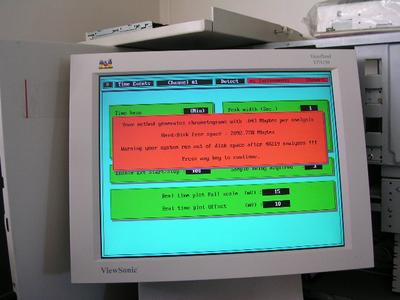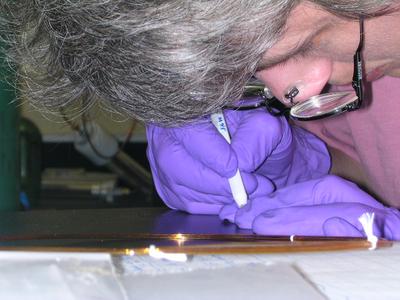14 June, 2004
Hours of daylight: 24 (again!)
Precipitation: trace
At long last, the equipment is working. Rich (still the camp manager, still affectionately known as the mayor) had the old computer he sent to Fairbanks returned to Toolik. Penney put in a new hard drive and we were in business!
Or nearly in business.
The gas chromatography was working, but was behaving weirdly.
(Despite the pop-up warning, we are NOT concerned that we only have enough memory for another 40,832 samples.) Amanda deduced that the column (the long, thin glass coil through which the samples are pushed) was leaking. The tricky part about replacing the column is that the ends of the column need to be PERFECTLY square to ensure the samples get in the column properly. Breaking glass is a quick and easy job; even a squirrel can do it. Scoring and cutting glass tubes that have perfectly square ends takes a considerably more patience. Amanda, Penney and Yo each took turns, and after about 45 minutes prevailed.
While the others were troubleshooting and fixing the gas chromatograph, I was measuring the samples from the photobleaching experiment we ran on Saturday and Sunday. To take the measurements, I used the miniature ultraviolet / visible light spectrometer (UV / Vis for short) attached to Penney's computer. The spectrometer uses light to identify the amount of the materials dissolved in the water. More information on how this cool gadget works will be coming in future posts. Stay tuned.
We took breaks to enjoy the clouds racing above the tundra, and watch them pour rain to the ground below.
Interesting fact to make you smarter:
As you look around the tundra, it is easy to see abundant vegetation and lots of surface water. What is less easy to see (and maybe hard to appreciate watching the rain and hail plummet from the sky into one of many lakes that dot the landscape) is that the tundra is technically a desert: it receives less than 25 cm of precipitation each year.
The reason the tundra appears so wet is that the precipitation drains so poorly. Several inches to several feet below the surface of the soil is a layer of permanently frozen ground called the permafrost (perma- permanent frost - frozen (ooh. that's surprise) So, instead of draining into the ground like it does at lower latitudes, when precipitation falls, much of it sticks around until it evaporates.
Amanda's Limerick
Our GC is working fine now
There is no more sweat on our brows
It was bad for a bit
And we almost quit
But we jumped this hurdle somehow.

1. Penney reinstalls the hard drive

2. Gas chromatograph is working

3. Penney cuts a square end on the chromatograph column

4. Preparing samples to measure how much ultraviolet light they absorb --

5. Ultraviolet / Visible Light Spectrometer

6. Rainstorm across the tundra
Contact the TEA in the field at
.
If you cannot connect through your browser, copy the
TEA's e-mail address in the "To:" line of
your favorite e-mail package.
|
